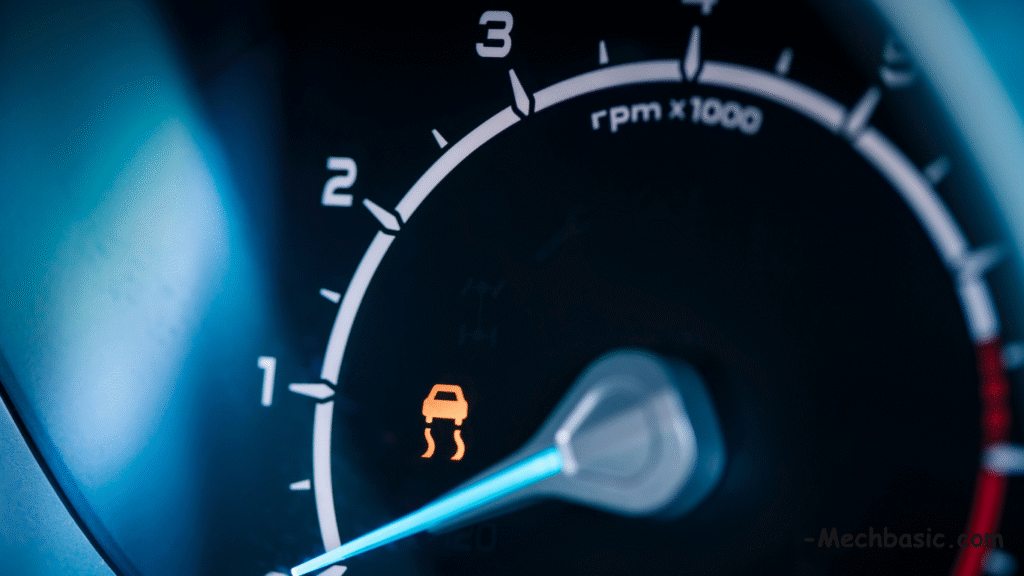
The Vehicle Dynamic Control (VDC) warning light is an indicator on the dashboard that relates to the vehicle’s stability control system. When illuminated, it tells the driver that the system is either actively working to maintain stability or has detected a malfunction and is disabled.
Below is a complete, engineering-level explanation of what the VDC warning light means, why it turns on, how the system behaves, and how to diagnose issues.
1. What Is the VDC Warning Light?
VDC (Vehicle Dynamic Control) is an electronic stability system.
Its warning light typically appears as:
- A car with skid marks behind it (ESC icon), or
- A light labeled “VDC”, “ESC”, “ESP”, or “VSC”, depending on manufacturer.
The warning light can either:
1. Blinking (Flashing)
→ Normal: VDC is actively correcting traction or stability loss.
2. Solid (Constant ON)
→ Problem: VDC has been disabled due to a malfunction.
2. When the VDC Light Blinks (Normal Operation)
A blinking VDC light means the stability system is actively intervening.
VDC activates when:
- You lose traction in snow, rain, mud, ice
- You oversteer or understeer
- You accelerate too aggressively
- Wheels spin unexpectedly
- Emergency maneuvers cause tire slip
- You drive on uneven/slippery roads
What the system is doing during blinking:
- Applying brake pressure to individual wheels
- Reducing engine power
- Adjusting torque split (in AWD vehicles)
- Using ABS hardware to stabilize the car
This is normal and indicates the system is protecting the vehicle.
3. When the VDC Light Stays ON (Malfunction)
A solid VDC warning light means the system is disabled due to a fault.
Common causes:
3.1 Faulty Wheel Speed Sensors (MOST COMMON)
Wheel speed sensors provide information for:
- ABS
- Traction Control
- VDC
Symptoms:
- ABS light may also come on
- Speedometer may fluctuate
- VDC, TCS, and hill-assist may all deactivate
Reasons sensors fail:
- Dirt, corrosion
- Broken sensor wires
- Damaged tone ring
- Wheel bearing wear
3.2 Steering Angle Sensor Fault
The steering angle sensor determines the driver’s intended direction.
If incorrect or uncalibrated:
- VDC cannot calculate desired yaw rate
- System shuts down
- Steering may feel unusual
Often occurs after:
- Alignment work
- Steering rack replacement
- Battery disconnect
- Collision/impact
3.3 Yaw Rate or Lateral G Sensor Failure
These sensors detect vehicle rotation and side forces.
Symptoms:
- VDC light stays on
- Vehicle may feel unstable at high speed
- Trouble codes for yaw sensor bias or malfunction
3.4 Low Battery or Charging Issues
VDC is sensitive to voltage drops.
Low voltage may occur due to:
- Weak battery
- Bad alternator
- Poor ground connection
Signs:
- VDC + ABS + TCS lights come on together
- Slow cranking
- Flickering interior lights
3.5 Tires or Wheels Affecting VDC
Incorrect tire conditions can disable the system:
- Uneven tire sizes
- Incorrect tire pressure
- Mismatched tread depth (AWD especially sensitive)
- Damaged wheels or hubs
Different wheel speeds confuse the system → VDC shuts off.
3.6 Brake System Problems
VDC uses the ABS hardware.
If ABS has an issue, VDC turns off too.
Possible causes:
- Low brake fluid
- Bad ABS module
- Air in brake lines
- Faulty ABS pump relays
3.7 VDC Switch Is OFF
Many vehicles have a button:
“VDC OFF”, “ESC OFF”, “TCS OFF”, “VSC OFF”.
If the driver manually disables it, the light will stay on.
4. Diagnosing a VDC Warning Light
Professionally, diagnosis requires an OBD-II scan tool that can read:
- ABS module codes
- Stability control module codes
- Live wheel-speed data
- Steering angle sensor readings
Typical fault codes:
- C1234: Wheel speed sensor failure
- C1101: Steering angle sensor
- C1143: Yaw rate sensor
- C1203: Low voltage to ABS/VDC module
5. How the Vehicle Behaves When VDC Is Disabled
When the VDC light is ON (system disabled):
What still works:
- Normal driving
- Basic braking
What stops functioning:
- Stability correction
- Traction control
- Torque vectoring
- ABS might still work (unless ABS is also faulted)
Driving characteristics:
- Easier wheelspin
- Harder to control in wet/icy conditions
- Greater risk of sliding
- Less predictable cornering stability
6. Conditions That Temporarily Disable VDC
Sometimes VDC turns off automatically due to temporary environmental issues.
Examples:
- Deep snow or mud
- Extremely uneven surfaces
- Chains or spare tire installed
- High brake temperature
- Sensor overheated
- Battery just reconnected (system needs calibration)
Often resolves after:
- Restarting the engine
- Cleaning wheels/sensors
- Driving several minutes for recalibration
7. Fixing the VDC Warning Light: What to Check
Quick checks (driver level):
- Check tire pressure
- Ensure all 4 tires are the same size
- Clean snow/mud from wheels
- Restart the vehicle
- Check if the “VDC OFF” switch is engaged
- Check brake fluid level
Technical checks (mechanic level):
- Scan for ABS/VDC trouble codes
- Inspect wheel speed sensors
- Recalibrate steering angle sensor
- Test yaw & lateral sensors
- Check alternator voltage output
- Inspect ABS pump/module
📌 Summary
The VDC warning light tells you the status of the stability control system:
✔ Blinking = System is working to stabilize the car
✔ Solid ON = System malfunction or disabled
Most common causes:
- Wheel speed sensor failure
- Steering angle sensor issue
- Low battery voltage
- Brake system issue
- Tire size or pressure mismatch
Driving with VDC off is possible but less safe, especially in poor conditions.
Other courses:



